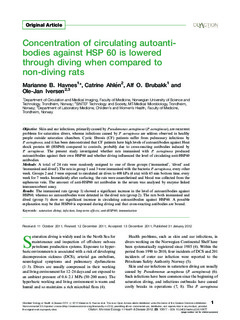| dc.contributor.author | Havnes, Marianne Bjordal | |
| dc.contributor.author | Ahlen, Catrine | |
| dc.contributor.author | Brubakk, Alf O | |
| dc.contributor.author | Iversen, Ole-Jan | |
| dc.date.accessioned | 2019-10-11T06:05:44Z | |
| dc.date.available | 2019-10-11T06:05:44Z | |
| dc.date.created | 2012-02-13T14:55:26Z | |
| dc.date.issued | 2012 | |
| dc.identifier.citation | Microbial Ecology in Health and Disease. 2012, 23 (1):10677 | nb_NO |
| dc.identifier.issn | 0891-060X | |
| dc.identifier.uri | http://hdl.handle.net/11250/2621481 | |
| dc.description.abstract | Objective: Skin and ear infections, primarily caused by Pseudomonas aeruginosa (P. aeruginosa), are recurrent problems for saturation divers, whereas infections caused by P. aeruginosa are seldom observed in healthy people outside saturation chambers. Cystic fibrosis (CF) patients suffer from pulmonary infections by P. aeruginosa, and it has been demonstrated that CF patients have high levels of autoantibodies against Heat shock protein 60 (HSP60) compared to controls, probably due to cross-reacting antibodies induced by P. aeruginosa. The present study investigated whether rats immunised with P. aeruginosa produced autoantibodies against their own HSP60 and whether diving influenced the level of circulating anti-HSP60 antibodies. Methods: A total of 24 rats were randomly assigned to one of three groups (‘immunised’, ‘dived’ and ‘immunised and dived’).The rats in group 1 and 3 were immunised with the bacteria P. aeruginosa, every other week. Groups 2 and 3 were exposed to simulated air dives to 400 kPa (4 ata) with 45 min bottom time, every week for 7 weeks. Immediately after surfacing, the rats were anaesthetised and blood was collected from the saphenous vein. The amount of anti-HSP60 rat antibodies in the serum was analysed by enzyme linked immunosorbent assay. Results: The immunised rats (group 1) showed a significant increase in the level of autoantibodies against HSP60, whereas no autoantibodies were detected in the dived rats (group 2). The rats both immunised and dived (group 3) show no significant increase in circulating autoantibodies against HSP60. A possible explanation may be that HSP60 is expressed during diving and that cross-reacting antibodies are bound. | nb_NO |
| dc.description.abstract | Concentration of circulating autoantibodies against HSP 60 is lowered through diving when compared to non-diving rats | nb_NO |
| dc.language.iso | eng | nb_NO |
| dc.publisher | Taylor & Francis | nb_NO |
| dc.rights | Navngivelse-Ikkekommersiell 4.0 Internasjonal | * |
| dc.rights.uri | http://creativecommons.org/licenses/by-nc/4.0/deed.no | * |
| dc.title | Concentration of circulating autoantibodies against HSP 60 is lowered through diving when compared to non-diving rats | nb_NO |
| dc.type | Journal article | nb_NO |
| dc.type | Peer reviewed | nb_NO |
| dc.description.version | publishedVersion | nb_NO |
| dc.source.volume | 23 | nb_NO |
| dc.source.journal | Microbial Ecology in Health and Disease | nb_NO |
| dc.source.issue | 1 | nb_NO |
| dc.identifier.doi | 10.3402/mehd.v23i0.10677 | |
| dc.identifier.cristin | 908384 | |
| dc.description.localcode | © 2012 Marianne B. Havnes et al. This is an Open Access article distributed under the terms of the Creative Commons Attribution-Noncommercial 3.0 Unported License (http://creativecommons.org/licenses/by-nc/3.0/), permitting all non-commercial use, distribution, and reproduction in any medium, provided the original work is properly cited. | nb_NO |
| cristin.unitcode | 194,65,25,0 | |
| cristin.unitcode | 194,65,15,0 | |
| cristin.unitname | Institutt for sirkulasjon og bildediagnostikk | |
| cristin.unitname | Institutt for klinisk og molekylær medisin | |
| cristin.ispublished | true | |
| cristin.fulltext | original | |
| cristin.qualitycode | 1 | |

